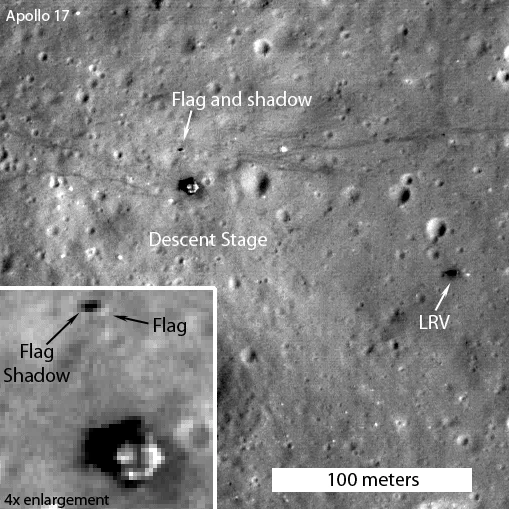When you first take your telescope into the backyard, the moon is most people’s first object to observe. When looking at the moon, it can shock you just how breathtaking the view was through the eyepiece; you may start asking yourself things like can telescopes see the American flag on the moon. You may even ask can telescopes see the moon landing site; let’s find out.
Unfortunately, you’re not going to be able to see the American flag through your backyard telescope. The reason for this is the smallest crater the human eye can see is 100km or 60 miles across. Something this size would take you 1 hour if it was a freeway driving at 60 mph. A backyard telescope will only be able to resolve craters about 1Km or 0.6 miles.
So, we know we can’t see the American flag from our backyard but is the American flag still on the moon? Let’s answer this and a few more questions on this fascinating object in the sky.
Can anyone confirm the flag is still there?
NASA, as you may already know have lots of lunar reconnaissance orbits that can resolve objects about 1 meter. With this unique technology, pictures are taken by NAZA can just make out the flag that was left by astronauts 1969. It is great to have confirmed that the flag is still on the moon, but that leaves many more questions.
Who put the American flag on the moon?
On July 16th, 1969, Apollo 11 launched from Kennedy Space Center with Neil A. Armstrong, Michael Collins, and Edwin Aldrin on board. Four days later, both Neil A. Armstrong and Edwin Aldrin landed on the moon. This was when they planted the American flag on the moon. Michael Collins didn’t stand on the moon as he orbited overhead in the command module.
What condition will the American flag be in?
The flag that Neil A. Armstrong and Edwin Aldrin planted on the moon was reported by Edwin Aldrin himself that the flag blew over by the rocket when they left the moon surface.
However, the flag was nylon and this wouldn’t last long under the extreme conditions on any lunar surface. It’s said that the strong UV light from the sun will have washed out all the colors on the flag by now. After some time the flag will become more and more brittle and will eventually crumble into dust.
Moonquakes will speed up the process of breaking down the American flag on the moon.
How many moon landings have there been?
There have been a total of 6 crewed moon landings on the moon between 1969 and 1972, with a total of 18 astronauts on the missions with 12 taking steps on the moon. All the astronauts have been men; Donald Trump has said that he plans to send the first woman to the moon before 2025.
Each mission had a total of 3 crew members with two crew members taking steps on the moon whilst the third crew member stayed in the command module and orbited overhead.
The last man two men on the moon was Gene Cernan and Jack Schmitt on Apollo 17 and it was Gene Cernan who was the last man to step off the moon.
Can telescopes see the moon landing site?
Again like the flag on the moon unfortunately we can’t make out any of the 6 moon landing sites or any junk left by the astronauts. If you wanted to see the lading site you would need a telescope 50 times bigger than that of the Hubble telescope to pick out the moon landing sites.
One of the most famous space telescopes is the Hubble and has a size of 3.2 m × 4.2 m (43.3 ft × 13.8 ft). However, this telescope is set to no longer be the biggest space telescope and that will soon be the James Webb Space Telescope that will be 20.197 m x 14.162 x (66.26 ft × 46.46 ft).
Conclusion
Reading all the above may leave you a little disappointed that we can’t actually see the American flag thought your backyard telescope. However, this doesn’t take away the fact that picking out different craters on the moon and seeing the moon thought a telescope is such an awesome experience.
There are many questions like why does the moon have craters? There are multiple amounts of questions people ask about the moon, and moon viewing can keep you entertained for years.
I really love observing the moon and I have put together some of the best books about the moon if you really want to dig deep and get some great facts about the moon.
NASA has a website packed full of information about the moon and many other planets and it’s well worth bookmarking the NASA website.




